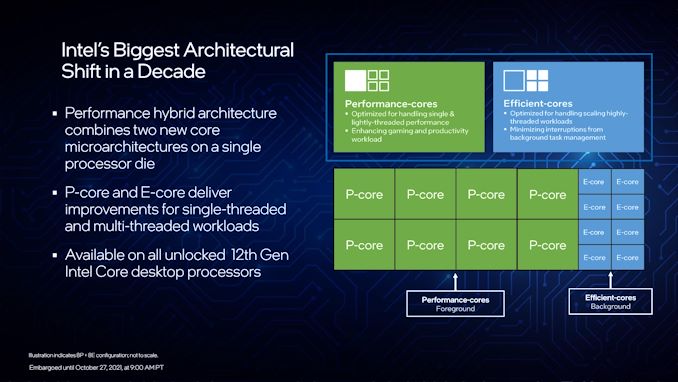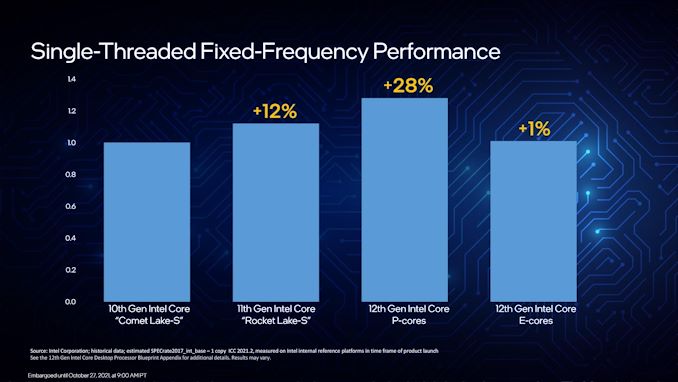Intel 12th Gen Core Alder Lake for Desktops: Top SKUs Only, Coming November 4th
by Dr. Ian Cutress on October 27, 2021 12:00 PM EST- Posted in
- CPUs
- Intel
- DDR4
- DDR5
- PCIe 5.0
- Alder Lake
- Intel 7
- 12th Gen Core
- Z690
A Hybrid/Heterogeneous Design
Developing a processor with two different types of core is not a new concept – there are billions of smartphones that have exactly that inside them, running Android or iOS, as well as IoT and embedded systems. We’ve also seen it on Windows, cropping up on Qualcomm’s Windows on Snapdragon mobile notebooks, as well as Intel’s previous Lakefield design. Lakefield was the first x86 hybrid design in that context, and Alder Lake is the more mass-market realization of that plan.
A processor with two different types of core disrupts the typical view of how we might assume a computer works. At the basic level, it has been taught that a modern machine is consistent – every CPU has the same performance, processes the same data at the same rate, has the same latency to memory, the same latency to each other, and everything is equal. This is a straightforward homogenous design that’s very easy to write software for.
Once we start considering that not every core has the same latency to memory, moving up to a situation where there are different aspects of a chip that do different things at different speeds and efficiencies, now we move into a heterogeneous design scenario. In this instance, it becomes more complex to understand what resources are available, and how to use them in the best light. Obviously, it makes sense to make it all transparent to the user.
With Intel’s Alder Lake, we have two types of cores: high performance/P-cores, built on the Golden Cove microarchitecture, and high efficiency/E-cores, built on the Gracemont microarchitecture. Each of these cores are designed for different optimization points – P-cores have a super-wide performance window and go for peak performance, while E-cores focus on saving power at half the frequency, or lower, where the P-core might be inefficient.
This means that if there is a background task waiting on data, or something that isn’t latency-sensitive, it can work on the E-cores in the background and save power. When a user needs speed and power, the system can load up the P-cores with work so it can finish the fastest. Alternatively, if a workload is more throughput sensitive than latency-sensitive, it can be split across both P-cores and E-cores for peak throughput.
For performance, Intel lists a single P-core as ~19% better than a core in Rocket Lake 11th Gen, while a single E-core can offer better performance than a Comet Lake 10th Gen core. Efficiency is similarly aimed to be competitive, with Intel saying a Core i9-12900K with all 16C/24T running at a fixed 65 W will equal its previous generation Core i9-11900K 8C/16T flagship at 250 W. A lot of that will be that having more cores at a lower frequency is more efficient than a few cores at peak frequency (as we see in GPUs), however an effective 4x performance per watt improvement requires deeper investigation in our review.
As a result, the P-cores and E-cores look very different. A deeper explanation can be found in our Alder Lake microarchitecture deep dive, but the E-cores end up being much smaller, such that four of them are roughly in the same area as a single P-core. This creates an interesting dynamic, as Intel highlighted back at its Architecture Day: A single P-core provides the best latency-sensitive performance, but a group of E-cores would beat a P-core in performance per watt, arguably at the same performance level.
However, one big question in all of this is how these workloads end up on the right cores in the first place? Enter Thread Director (more on the next page).
A Word on L1, L2, and L3 Cache
Users with an astute eye will notice that Intel’s diagrams relating to core counts and cache amounts are representations, and some of the numbers on a deeper inspection need some explanation.
For the cores, the processor design is physically split into 10 segments.
A segment contains either a P-core or a set of four E-cores, due to their relative size and functionality. Each P-core has 1.25 MiB of private L2 cache, which a group of four E-cores has 2 MiB of shared L2 cache.
This is backed by a large shared L3 cache, totaling 30 MiB. Intel’s diagram shows that there are 10 LLC segments which should mean 3.0 MiB each, right? However, moving from Core i9 to Core i7, we only lose one segment (one group of four E-cores), so how come 5.0 MiB is lost from the total L3? Looking at the processor tables makes less sense.
Please note that the following is conjecture; we're awaiting confirmation from Intel that this is indeed the case.
It’s because there are more than 10 LLC slices – there’s actually 12 of them, and they’re each 2.5 MiB. It’s likely that either each group of E-cores has two slices each, or there are extra ring stops for more cache.
Each of the P-cores has a 2.5 MiB slice of L3 cache, with eight cores making 20 MiB of the total. This leaves 10 MiB between two groups of four E-cores, suggesting that either each group has 5.0 MiB of L3 cache split into two 2.5 MiB slices, or there are two extra LLC slices on Intel’s interconnect.
| Alder Lake Cache | |||||||
| AnandTech | Cores P+E/T |
L2 Cache |
L3 Cache |
IGP | Base W |
Turbo W |
Price $1ku |
| i9-12900K | 8+8/24 | 8x1.25 2x2.00 |
30 | 770 | 125 | 241 | $589 |
| i9-12900KF | 8+8/24 | 8x1.25 2x2.00 |
30 | - | 125 | 241 | $564 |
| i7-12700K | 8+4/20 | 8x1.25 1x2.00 |
25 | 770 | 125 | 190 | $409 |
| i7-12700KF | 8+4/20 | 8x1.25 1x2.00 |
25 | - | 125 | 190 | $384 |
| i5-12600K | 6+4/20 | 6x1.25 1x2.00 |
20 | 770 | 125 | 150 | $289 |
| i5-12600KF | 6+4/20 | 6.125 1x200 |
20 | - | 125 | 150 | $264 |
This is important because moving from Core i9 to Core i7, we lose 4xE-cores, but also lose 5.0 MiB of L3 cache, making 25 MiB as listed in the table. Then from Core i7 to Core i5, two P-cores are lost, totaling another 5.0 MiB of L3 cache, going down to 20 MiB. So while Intel’s diagram shows 10 distinct core/LLC segments, there are actually 12. I suspect that if both sets of E-cores are disabled, so we end up with a processor with eight P-cores, 20 MiB of L3 cache will be shown.













395 Comments
View All Comments
Bik - Saturday, October 30, 2021 - link
Let's check your argument. If 4 small cores > 1 big core while using same die area, how about just one big core for single thread performance and give us an addition of 24 more small cores? Clearly Intel (and Apple) not doing that, rather they reduce number of small cores (m1 pro, core i5 alderlake) instead. There clearly a catch, we'll know when review is out.Bik - Saturday, October 30, 2021 - link
7*4=28 cores. my math sucks.Wrs - Saturday, October 30, 2021 - link
For 1P 28E they'd probably run into fabric/coherency limits. If you have 30 nonlocking threads then that could be a rather efficient design. Let's see if we have that in a modern computer... *stares at the 10.5k CUDA cores on an RTX card*nandnandnand - Saturday, October 30, 2021 - link
Simple. You can have more than one task running at a time that can't be parallelized and will only respond to greater single-thread performance, and one or more applications running that can use multiple threads but not scale to benefit from dozens or hundreds of cores.Games will typically be using up to 8 cores in the upcoming generation because the PS5 and XSX have 8 cores and will be optimized to get the most out of 8. So Intel puts 8 big cores in the flagship but stops there. If the game can also use some of the small cores, great.
Also, we already know that next year's Raptor Lake will have up to 8 big cores and 16 small cores, and it looks like Intel will go to 8 big cores and 32 small cores after that. They can tweak to improve IPC across all the cores, but the small cores will be getting a greater proportion of the die area going foward. Apple has a different strategy, if their leaks are correct.
ThinkingReviewer200 - Friday, October 29, 2021 - link
Thanks for the article :)For the second page of the review, the sentence, "For performance, Intel lists a single P-core as ~19% better than a core in Rocket Lake 11th Gen" may have an inaccuracy. This percentage should perhaps be ~14% for according to the graph image 128% - 112% is 16% then 16%/112% is ~14% depending on the perspective, in this case perhaps the 11th gen. However, check this logic and math for these are percents inside percents calculations.
mode_13h - Saturday, October 30, 2021 - link
They're not additive. It's easier to see, if you drop the percentages and just call a Rocket Lake core 1.12x as fast as a Comet Lake core. Then, Alder Lake-P is 1.28x as fast as comet lake. So, Alder Lake-P should be 1.28/1.12 as fast as a Rocket Lake core which is 1.143 or about 14%.mode_13h - Saturday, October 30, 2021 - link
Ah, but if you look closely at the chart on page 2, it says "fixed-frequency". So, that's talking about essentially "instructions per clock". However, the stats on the last page are including clock speed differences.So, I guess that's how they get up to 19%? It would take only a clock speed increase of about 4.3% to makeup the difference. It's still not easy to see where they find that, but if both cores throttle back and Alder Lake's P core manages to hold a higher clock speed, then it's not hard to see how we could reach a 4.3% difference.
tech4fun - Friday, October 29, 2021 - link
I just canceled my Netflix account. Fanboi battle royale!nandnandnand - Friday, October 29, 2021 - link
What took you so long?Kendog52404 - Sunday, October 31, 2021 - link
Does Alder Lake support DDR4-3000 memory? Or, does it need to be 3200? I haven't bought memory for about 5 years, and it's DDR4-3000 that I had been planning to bring over from the old board. If I have to buy new memory, regardless, that changes things, and I'll need to take a serious look at DDR5.